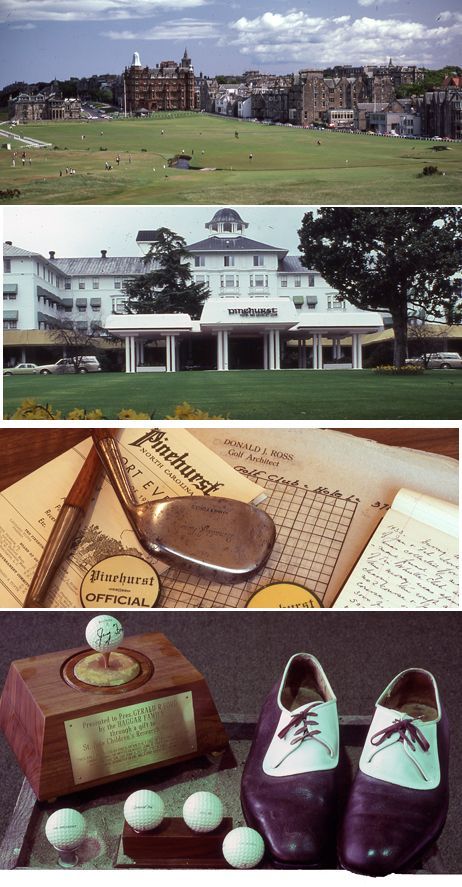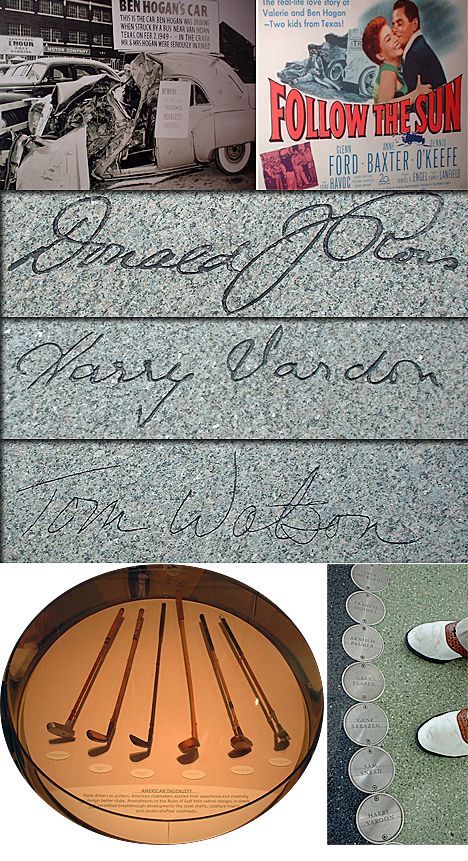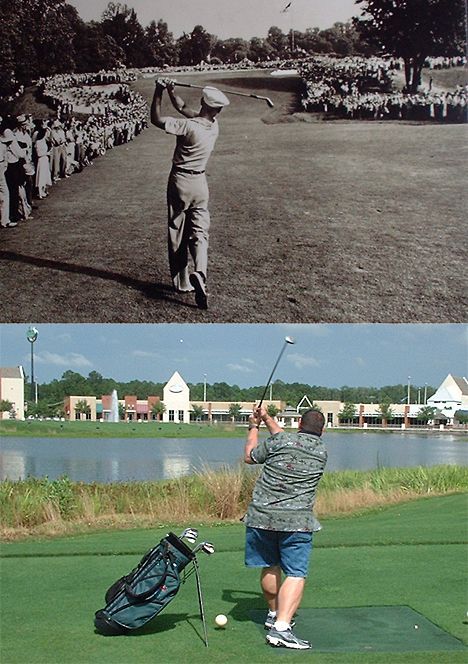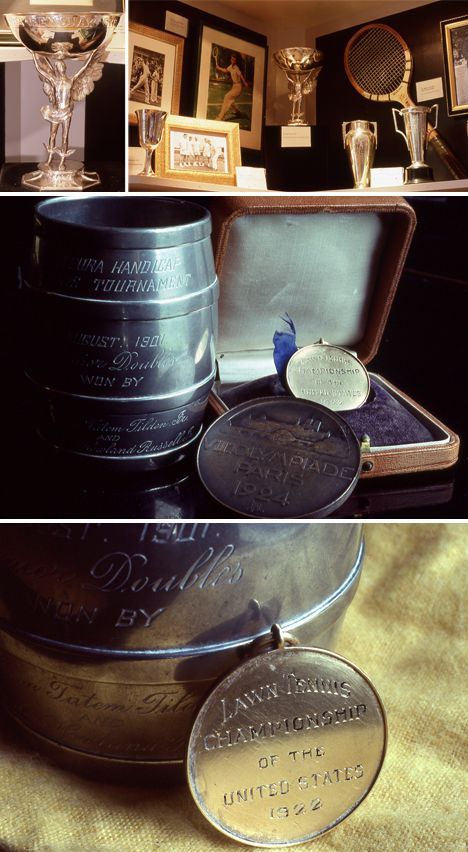Article
Matching the Pros at the Sports Halls of Fame
Author(s):
Sometimes it's easier to admire the records of athletes when it's a sport the spectators can more readily play, such as tennis, golf and swimming.
Photography by the authors
Sports fans marvel at what their favorite professionals can achieve on the sports field. It’s unreal to see a running back sprint 90 yards downfield in American football or a baseball hitter launching three home runs in a single game in the World Series.
B
ut a golf score that grabbed the 1997 Masters by 12 shots or a tennis final at Wimbledon in 2008 — after a play that lasted four hours and 48 minutes and defeated the defending champion — must be particularly unnerving to those who play the game themselves.
Golf
You can pay your respects to this very old game in many places — from the Royal & Ancient in St. Andrews in Scotland to Pinehurst in North Carolina in the United States
.
is
It an ancient sport. Mary Queen of Scots played it and she was executed by her cousin, Queen Elizabeth of England, more than 500 years ago — though not for playing golf. So it’s reasonable to expect walnut paneling, polished brass, subdued lighting and a sense of awe when you walk its halls. You got that in the original hall of fame of golf and the Tufts Archives at Pinehurst: notes scribbled by Pinehurst golf architect Donald Ross, shoes used by President Ford and balls he shot, though not the ones that hit a spectator. Remember?

Some, who look back with reverence on the most difficult game in the world, this pastime of placing a small ball somehow in a small hole, might find the World Golf Hall of Fame just south of St. Augustine, Fla. a bit stark: it’s all natural light, polished wood and plate glass — with information on the great players surprisingly scanty.
This emphasis on the history of the game with relatively little on the famous names of golf may well be because those names are off elsewhere. Jack Nicklaus, for example, has his own museum in the Ohio State University in Columbus, Ohio and Arnold Palmer has his in the USGA Museum in Far Hills, N.J. — and good old Sam Snead has distributed all his life on the walls of his string of Sam Snead’s Taverns across the country.

The interactive part of the World Golf Hall of Fame works well although the display of personal items from famous players seems uninspired, from one player’s school boy lunch box to a model of another player’s personal airliner.
Even at Pinehurst — where a leaking roof dripped rain for months on the statue of everyone’s favorite, Bobby Jones — the famous names in golf seemed disinterested in contributing to the expense of repairing the roof.

This hall of fame of golf just south of St. Augustine in Florida is still worth a visit, showing everything, at the time of our visit, a tribute to Ben Hogan — and the courageous comeback he made after almost being destroyed by a bus, a response brave enough to interest Hollywood — and the history of the game from golf balls to the club itself.

The site for the Hall of Fame is spacious. It offers a chance for visitors to look at old photographs showing marvelous fluid swings then try for themselves outside, not always with comparable results. It’s a bit of a drive from Jacksonville but both entertainment and shopping lie handy in the World Hall Village and there is an IMAX theater at the hall.
Tennis
There’s more to do for the companion who is not interested in sports at the International Tennis Hall of Fame in Newport, R.I. The hall is in an interesting 1880 building (the original Newport Casino) in an attractive seaport city. Stanford White, the famous architect, co-designed the casino in his first contract.
The first U.S. National Lawn Tennis Championships were held here in 1881. The building became the hall of fme in 1954. Although it offers 20,000 square feet and has more than 16,000 items in its permanent collection and, arguably, tennis has never been more exciting than today, visitors seem to congregate in the more leisurely era of the past.

This hall of fame is the only one where the game is still played at the same location where Bill Tilden, Don Budge and Pancho Gonzales once thrilled an elegant crowd. A replica of David Wynne’s Wimbledon statue of Fred Perry graces the lawn. Perry was one of the original maestros of the game: He won one French Open, one Australian Open, two U.S. professional championships, three U.S. Opens, three Wimbledons and 34 Davis Cup Singles!
Inside the pavilion visitors find a period scene where men in white suits and straw hats clearly wait for their mint juleps beside the framed 1933 tennis racquet and ball used by Jimmy Van Allen to win the U.S. Amateur Singles.

tennis elbow
The artifacts from the glory days of lawn tennis surround us such as the tribute to Don Budge (who essentially gave the world when he initiated this strange swing: the backstroke). Budge won the Renshaw Cup (the precursor of the Wimbledon Cup) in 1937 and he was the first (and youngest) to win the Grand Slam in 1938. He was an absolute natural who never played the game till he was 14. His victory over von Cramm in the Davis Cup is considered one of the most thrilling games in tennis — he was down 1-4 in the final set but fought back to win 8-6.
Other exhibits to remind visitors of the great days of the sport include “Big” Bill Tilden’s 1922 U.S. Open medal, his first trophy — and his 1924 Olympic medal. A biographer, Frank Deford, once said Gentleman Bill “played for himself, for his country and for posterity.” He was the first American to play at Wimbledon and the first American to win the singles title. He won 138 of 192 tournaments and was once labeled “invincible.”
Tilden played with celebrities, became an actor and friend of Charlie Chaplin and gave tennis lessons to Greta Garbo and Douglas Fairbanks. He was ultimately charged with acts of pederasty and imprisoned for a year. When he, the first great tennis superstar, died of a myocardial infarction at the age of 60, he had sadly lost all his friends and all his money.
Swimming
At first glance it’s hard to imagine any mystique to swimming. The old swimming hole on the river or the town community pool of yesterday hardly justifies a hall of fame. Indeed. the only swimming questions the public could want answered might be: is it true that Johnny Weissmuller personally created his Tarzan call? (Yes, he did, but more to the point, he won 67 world championships and five Olympic Golds.) Is it true that Mark Spitz had 10 more degrees range of motion at his ankle than normal persons? (Apparently so.) And does Michael Phelps actually have acromegaly? (No one knows.)
The late Buck Dawson, the first executive director of the International Swimming Hall of Fame in Fort Lauderdale, Fla. used to tell visitors one secret about Weissmuller: This swimmer, who never lost a race in 10 years of amateur swimming in distances from 50 yards to half a mile, was so good his coach, Bill Bachrach, made him pace himself each time he swam so he would keep the sports press continuously interested. Each time he swam he’d shave a fraction of a second off his time, whereas if he really tried he would have blown many seconds off his record.
None of Weissmuller’s records have lasted. Records never do. When Spitz led the way for dominance in the sport someone added his moustache to the large concrete statue outside the Hall of Fame, saying it now resembled Spitz.

Olympic medals are displayed in the middle image: from left to right 1972 Games, Ancient Greece, and one from the re-activated Olympic games in Greece in 1896.
Other names on show include Gerald Ford and Ronnie Reagan. Both were strong swimmers. Reagan captained his college swim team and is credited with saving 77 lives as a lifeguard. John F. Kennedy was on the first Harvard swim team to beat Yale.
There was criticism when actress-swimmer Esther Williams was inducted 50 years ago. Some board members said she had become professional too early in her career. Yet women figure prominently in this hall of fame, no surprise because swimming is about the only sport requiring physical strength where women can compete on a par with men and, in some events like distance swimming, they are clearly superior.
before
Physician visitors will be interested to discover a photograph of Stubby Kruger in the files. He was at that time the only man whose existing world record (400-yard backstroke) had been broken by a woman, Sybil Bauer. She knocked four seconds off it! This was swimsuit design changed swimming records.
Bauer went on to win an Olympic Gold and eight national and world records then sadly died of cancer at 22 with her distraught fiancé Ed Sullivan, by her side. Her death made people fearful that exercise could be harmful.
Other swimmers emerged to reassure the woman’s world. Betty Becker Pinkerton won a national championship while pregnant with twins. She later won two Olympic medals. Then Gertrude Edele swam the treacherous English Channel. She was not only the first woman to do it, but she did it in a time faster than any man’s. Then there was Ethelda Bleibtrey who overcame polio to become the first triple Olympic gold medal swimmer.
Bleibtrey has another place in the records: she was cited for removing her stockings at Manhattan Beach in Brooklyn in 1919 and arrested for “nude bathing.”
The Man Who Cried Orange: Stories from a Doctor's Life.
The Andersons, who live in San Diego, are the resident travel & cruise columnists for Physician's Money Digest. Nancy is a former nursing educator, Eric a retired MD. The one-time president of the NH Academy of Family Practice, Eric is the only physician in the Society of American Travel Writers. He has also written five books, the last called




